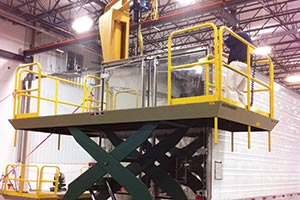Senior Reporter
US Trailer Orders Fall by 65% in September as Market Returns to More ‘Typical’ Demand

This story appears in the Oct. 24 print edition of Transport Topics.
Trailer orders in September fell below 13,000 as the market continues to adapt and reshape itself after a banner 2015, analysts said.
ACT Research Co. estimated orders at 12,950, down about 65% from 35,952 a year earlier.
“It seems likely we are looking at what might be a typical year through the lenses that just viewed a record year,” said Glenn Harney, chief sales officer of Hyundai Translead.
ACT’s estimate was preliminary, but the company expected the total to be within 5% of the net order number.
September orders are “a reassessment by fleets of what current market conditions are,” said Frank Maly, ACT director of commercial vehicle transportation research and analysis. “It may well be [the market is] returning to an order-timing pattern that is a little more normal, less impacted by those pull-ahead pressures” from last year and 2014, when the backlog was extensive and fleets sought scarce slots.
Fleet financials and freight rates are not as robust as they were a year ago, Maly said, so “there is less pressure, less incentive for fleets to get in line.”
In a related development, September marked the first year-over-year decline in the American Trucking Associations tonnage index since October 2015 as the metric fell 5.8%, the group said.
The weak economy offers little chance of strong gains in the near term while a correction in inventories continues, ATA Chief Economist Bob Costello said.
Analyst Michael Baudendistel, with Stifel, Nicolaus and Co., lowered his 2017 trailer production estimate to 235,000 units from 250,000.
That estimate compares with ACT’s forecast of about 240,000 units, he said in a note to investors.
“We are increasing our 2018 production estimate slightly, to 225,000 units from 215,000, largely to reflect a shift in production from 2017 to 2018. Our 2018 estimate remains considerably below ACT’s estimate of roughly 245,000 units,” Baudendistel wrote.
Research company FTR forecasts factory shipments of trailers to be 240,000 in 2017 and 265,000 in 2018, said Don Ake, vice president of commercial vehicles.
FTR pegged net trailer orders for September at 11,800.
“This is a market that is correcting, not collapsing,” Ake said.
Refrigerated vans still are very strong, and dry vans are doing OK, but the vocational trailers are basically tracking the Class 8 orders — as they have for the past nine months, he said.
Instead of placing “huge, big orders” out 12 months as they did last year, fleets “probably won’t place them past three [months], and they will be conservative on those three,” Ake said.
Manufacturers said orders had begun to flow for 2017.
“Quoting for 2017 has begun in earnest, whereas it started in August and September of last year,” Hyundai Translead’s Harney said. “The numbers look to be down but not too alarming numbers.”
David Giesen, vice president of sales at Stoughton Trailers, said the company had a normal month of ordering — seasonally adjusted and compared with typical historical numbers. “Overall, the [monthly] number seems to be OK. From a dry van standpoint, the normal order volume should be in the range of 5,000 to 10,000,” Giesen said.
Industry backlogs also are in good shape, said Charles Willmott, chief sales officer at Strick Group.
Although shorter than what they were earlier in the year, “The current, four- to six-month production backlogs are a very healthy and sustainable level that should please both the [trailer manufacturers] and carriers,” Willmott said.
But likely ongoing factors affecting the market include turmoil in the ocean carrier markets and reduced imports from Asia, election year anxiety and the strength of the U.S. dollar relative to Canada, he said.

